Delahaye's 155 V12 chassis no. 48774: the worst car they ever built
Author
- André Vaucourt
Date
- September 25, 2012
Related articles
- Delahaye - René Dreyfus and the upset at Pau, by Leif Snellman
- Delahaye 138 - 1933-'35: why Delahaye decided to go racing, by André Vaucourt
- Delahaye 135 - 1935-'36: a new chassis for the luxury market, by André Vaucourt
- Delahaye 135 - 1936: dominating the 1936 French racing season, by André Vaucourt
- Delahaye 135 - 1936: Delahaye wins nine out of 18 races, by André Vaucourt
- Delahaye 135/145 - 1937: winning big prizes, by André Vaucourt
- Delahaye 135/145/155 - 1938: Delahaye wins the Pau and Cork GPs and comes 1, 2, 4 at Le Mans, by André Vaucourt
- Delahaye 135/145 - 1939: not a very good year for Delahaye, and a terrible year for the world, by André Vaucourt
- Delahaye 135/145/155 - 1945-'46: after five years of war, by André Vaucourt
- Delahaye 135/145/155 - 1947-'48: racing with cars over 12 years old, by André Vaucourt
- Delahaye 145 - What became of the Delahaye 145 V12 chassis no. 48771?, by André Vaucourt
- Delahaye 145 - The history of Delahaye 145 V12 chassis no. 48775, by André Vaucourt
- Delahaye 145 - The brief history of Delahaye 145 V12 chassis no. 48772, by André Vaucourt
- Delahaye 145 - The short history of Delahaye 145 V12 chassis no. 48773, by André Vaucourt
Who?René Dreyfus What?Delahaye 155 Where?Donington Park When?1938 Donington GP |
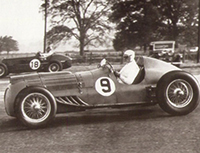 |
Why?
It's early 1938. German cars are winning everywhere. After the victories at Pau and Cork by 145 V12 no. 48771 (the car that won the Prix du Million in August 1937) Lucy O’Reilly Schell and her husband Laury ask Delahaye's managing director Charles Weiffenbach to build them a single-seater racing car that is able to compete with the German, Italian and British machines. Design engineer Jean François is set to work and comes up with an entirely new chassis. It's very sophisticated and complicated but uses the same engine as the type 145 cars. Laury Schell commissions the bodywork, carrying no. 5886, to famous coachbuilder Henri Chapron.
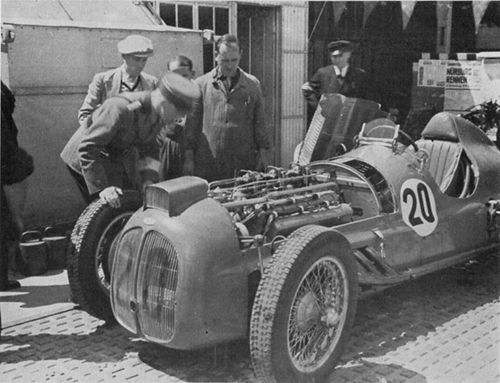
The 155 at scrutineering for the 1938 German GP. (Jean-Maurice Gigleux collection)
The car is planned to make its debut at no lesser race than the 1938 German GP, but René Dreyfus is only able to do some practice laps. The car is withdrawn. In his book My Two Lives Dreyfus later wrote these telling words: "The monoposto Delahaye was all wrong… we tried it during practice, the engine was good but the car just wouldn’t stay on the road.”
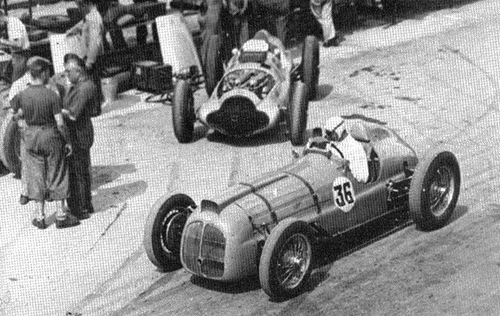
In practice for the 1938 Coppa Acerbo at Pescara. (Jean-Maurice Gigleux collection)
Three weeks later at the Coppa Acerbo, Pescara, Dreyfus gives it another go but again his efforts are in vain. This time, he has to give up due to suspension problems. A week later at Donington, Dreyfus gets the car into the race but has to retire the car after 33 of the 80 scheduled laps. A broken oil pipe is at fault. All this is leaving the Schells quite disgusted, and they decide to sell the car along with four other type 145s.
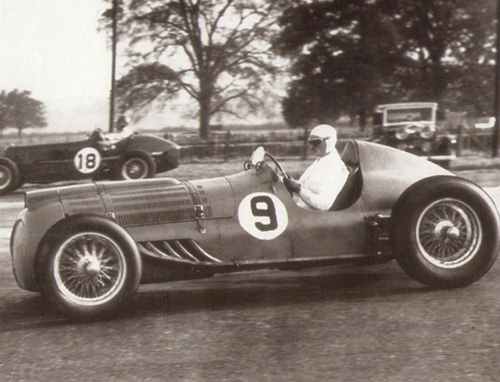
Dreyfus driving at the 1938 Donington GP. (Jean-Maurice Gigleux collection)
| date | race | no. | driver | result |
| 24/07/38 | German GP | 20 | Dreyfus | DNS |
| 14/08/38 | Coppa Acerbo | 36 | Dreyfus | DNS |
| 22/10/38 | Donington GP | 9 | Dreyfus | DNF |
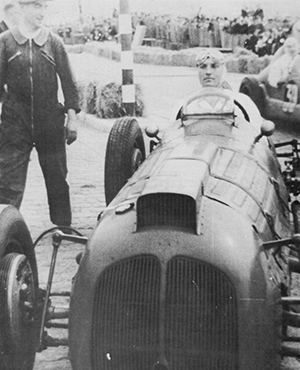
Paul Friderich during his misery at the 1946 Marseille GP. (Jean-Maurice Gigleux collection)
So what happened to the car after the war? First it was sold to the Ecurie Blanche et Noire, owned by Ernest Friderich of Bugatti fame, to be driven by his son Paul. Paul's first entry came at the Nice GP but the car was deemed ineligible for the race. At the Marseille GP, the car suffered no end of trouble. First of all, during practice, the oil reservoir exploded, leaving young and handsome Paul drenched in oil, to the dismay of his dad. Then, just before the start of the first heat, the car spat a valve through its exhaust, which lodged itself in a garage door! The car nevertheless took the start of the first heat, firing on only eleven cylinders. It managed a 4th place, completing the 15 laps, but in the final Paul had completed just 5 laps of the 35 when the car caught fire...
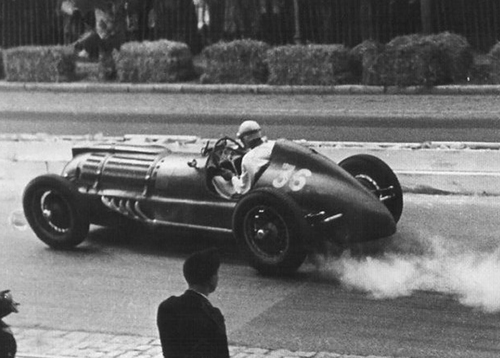
Yet more trouble at the 1946 Marseille GP. (Jean-Maurice Gigleux collection)
At the Saint Cloud GP, known also as the Coupe René Le Begue, Paul made to lap 10 of 35 when the car broke down. Then he entered the Burgundy GP but failed to show up. Sick and tired of his Delahaye, Friderich sold it to Jean Achard who entered it in the Circuit des Trois Villes but it was all over very quickly when Achard was disqualified for an irregular start .At the Nimes GP, the car was driven by Pierre "Levegh", but he also failed to finish. (By the way, Achard himself was driving a 3-litre Delage and crashed on the first lap.)
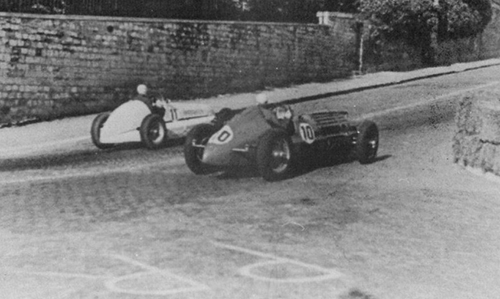
Paul Friderich at the 1946 Saint Cloud GP. (Jean-Maurice Gigleux collection)
However, the worst was yet to come...
Before the Albi GP, the rear suspension was modified by replacing the original transverse leaf-spring cluster by two semi-elliptic lateral leaf springs similar to the ones used on the 145s, in the hope of gaining better road-holding abilities. Sadly though, Achard’s car lost the left-hand rear wheelat the pit turn on lap 21. The wheel went flying into the grandstand, killing a lady spectator and injuring a dozen people.
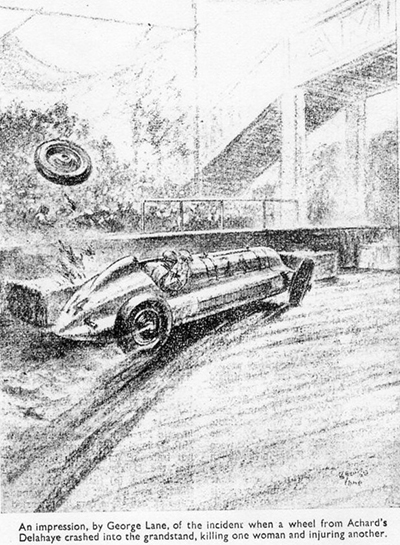
Autocar's artist's impression of Jean Achard's accident in the 1947 Albi GP.
However, the car bore no.20 instead of no.14.
A month later, at the Comminges GP, Achard didn’t have the heart to take the start and sold the car to André Simon who one year later, again at the Comminges GP, came in miraculously as a classified 7th, completing 24 of the 30 laps.
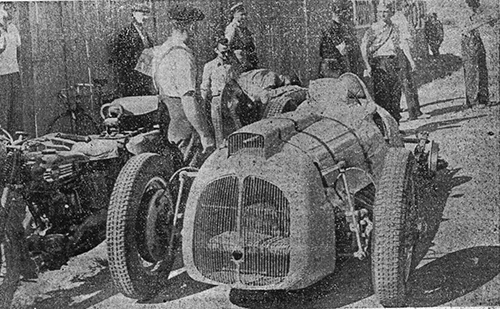
Inspection of the other rear wheel after Achard's deadly accident at Albi.
The failing wheel is clearly missing.
| date | race | no. | driver | result |
| 22/04/46 | Nice GP | 44 | Friderich | DNS |
| 12/05/46 | Marseille GP | 36 | Friderich | DNF |
| 09/06/46 | Saint Cloud GP | 10 | Friderich | DNF |
| 07/07/46 | Bourgogne GP | 16 | Friderich | DNS |
| 25/08/46 | Circuit Trois Villes | 10 | Achard | DSQ |
| 01/06/47 | Nimes GP | 54 | "Levegh" | DNF |
| 13/07/47 | Albi GP | 20 | Achard | DNF |
| 10/08/47 | Comminges GP | 10 | Achard | DNS |
| 01/08/48 | Comminges GP | 24 | Simon | 7th |
This spelled the end of the worst car ever built by Delahaye. After that, it disappeared completely and probably ended up on a scrap heap, which was positively the best thing that could be done to it.
